Paper Menu >>
Journal Menu >>
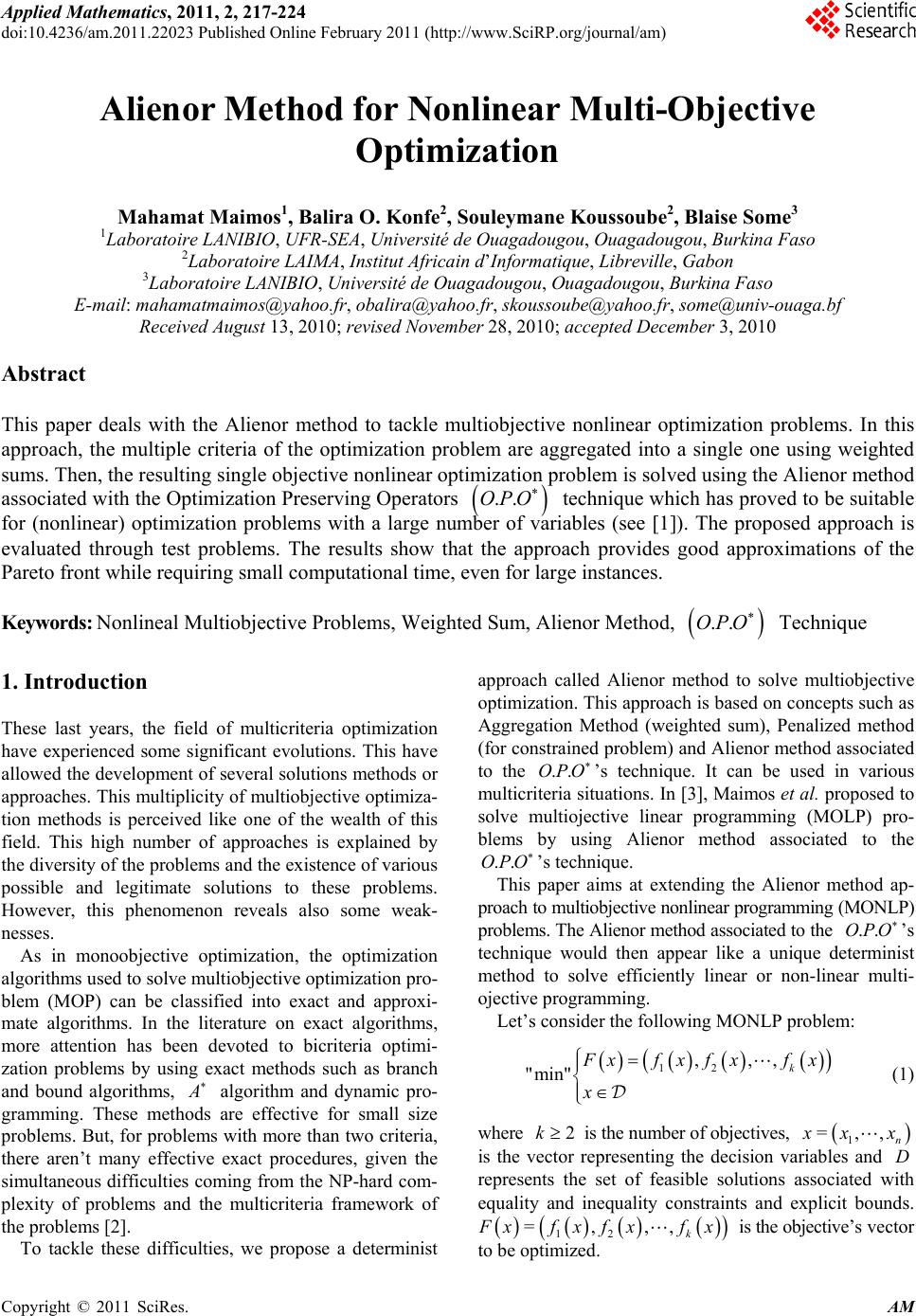 Applied Mathematics, 2011, 2, 217-224 doi:10.4236/am.2011.22023 Published Online February 2011 (http://www.SciRP.org/journal/am) Copyright © 2011 SciRes. AM Alienor Method for Nonlinear Multi-Objective Optimization Mahamat Maimos1, Balira O. Konfe2, Souleymane Koussoube2, Blaise Some3 1Laboratoire LANIBIO, UFR-SEA, Université de Ouagadougou, Ouagadougou, Burkina Faso 2Laboratoire LAIMA, Institut Africain d’Informatique, Libreville, Gabon 3Laboratoire LANIBIO, Université de Ouagadougou, Ouagadougou, Burkina Faso E-mail: mahamatmaimos@yahoo.fr, obalira@yahoo.fr, skoussoube@yahoo.fr, some@univ-ouaga.bf Received August 13, 2010; revised November 28, 2010; accepted December 3, 2010 Abstract This paper deals with the Alienor method to tackle multiobjective nonlinear optimization problems. In this approach, the multiple criteria of the optimization problem are aggregated into a single one using weighted sums. Then, the resulting single objective nonlinear optimization problem is solved using the Alienor method associated with the Optimization Preserving Operators ..OPO technique which has proved to be suitable for (nonlinear) optimization problems with a large number of variables (see [1]). The proposed approach is evaluated through test problems. The results show that the approach provides good approximations of the Pareto front while requiring small computational time, even for large instances. Keywords: Nonlineal Multiobjective Problems, Weighted Sum, Alienor Method, ..OPO Technique 1. Introduction These last years, the field of multicriteria optimization have experienced some significant evolutions. This have allowed the development of several solutions methods or approaches. This multiplicit y of multiobjective optimiza- tion methods is perceived like one of the wealth of this field. This high number of approaches is explained by the diversity of the problems and the existence of various possible and legitimate solutions to these problems. However, this phenomenon reveals also some weak- nesses. As in monoobjective optimization, the optimization algorithms used to solve multiobjectiv e op timization pro- blem (MOP) can be classified into exact and approxi- mate algorithms. In the literature on exact algorithms, more attention has been devoted to bicriteria optimi- zation problems by using exact methods such as branch and bound algorithms, A algorithm and dynamic pro- gramming. These methods are effective for small size problems. But, for problems with more than two criteria, there aren’t many effective exact procedures, given the simultaneous difficulties coming from the NP-hard com- plexity of problems and the multicriteria framework of the problems [2]. To tackle these difficulties, we propose a determinist approach called Alienor method to solve multiobjective optimization. This approach is based on concepts such as Aggregation Method (weighted sum), Penalized method (for constrained problem) and Alienor method associated to the ..OPO ’s technique. It can be used in various multicriteria situations. In [3], Maimos et al. proposed to solve multiojective linear programming (MOLP) pro- blems by using Alienor method associated to the ..OPO ’s technique. This paper aims at extending the Alienor method ap- proach to multiobjective non linear programming (MONLP) problems. The Alienor method associated to the ..OPO ’s technique would then appear like a unique determinist method to solve efficiently linear or non-linear multi- ojective programming. Let’s consider the fol l o wi n g MONLP problem: 12 ,,, "min" k F xfxfxfx x (1) where 2k is the number of objectives, 1 =,, n x xx is the vector representing the decision variables and D represents the set of feasible solutions associated with equality and inequality constraints and explicit bounds. 12 =,,, k F xfxfx fx is the objective’s vector to be optimized. 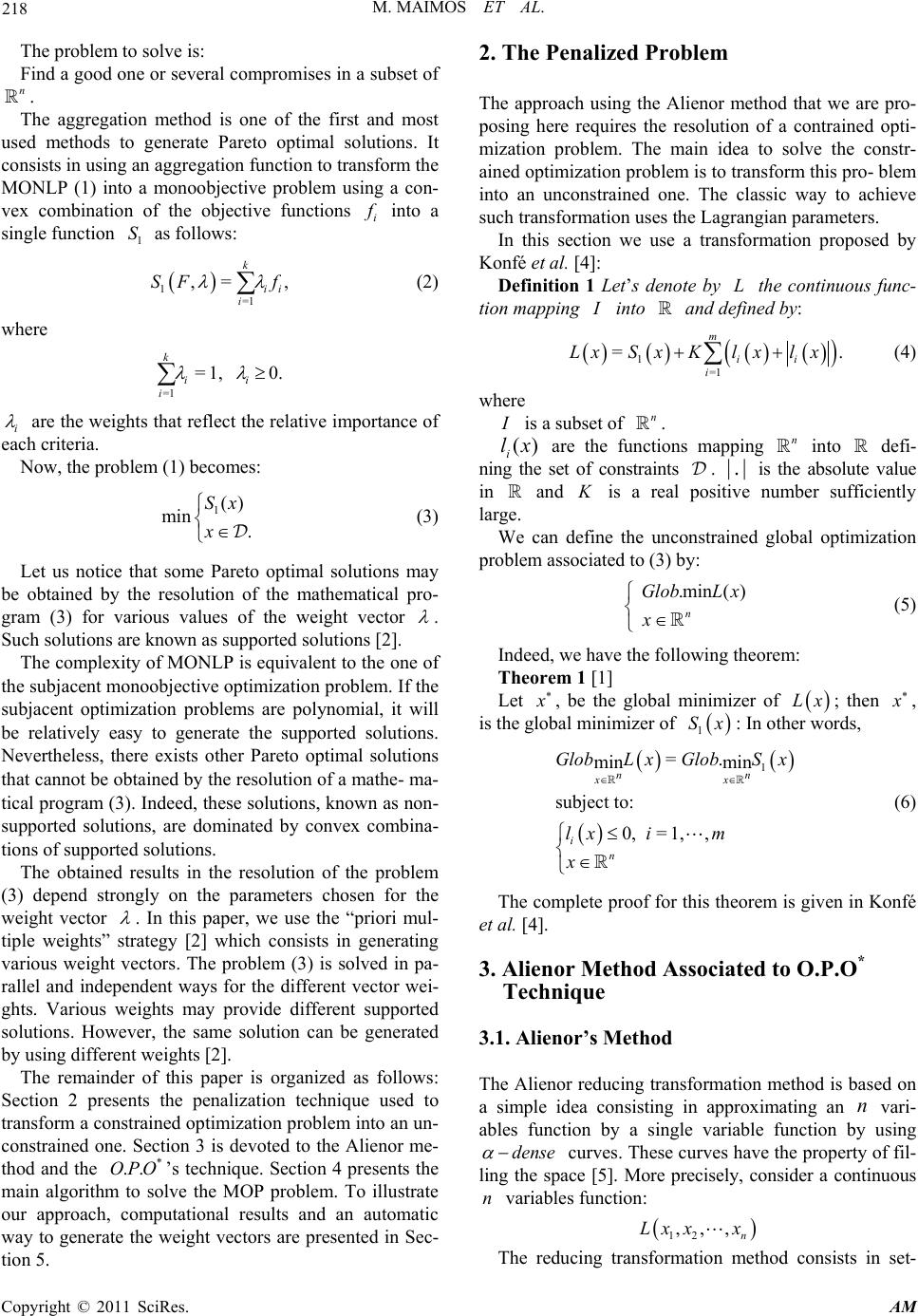 M. MAIMOS ET AL. Copyright © 2011 SciRes. AM 218 The problem to solve is: Find a good one or several compromises in a subset of n . The aggregation method is one of the first and most used methods to generate Pareto optimal solutions. It consists in using an agg r ega tion fun ctio n to transform the MONLP (1) into a monoobjective problem using a con- vex combination of the objective functions i f into a single function 1 S as follows: 1=1 ,= , k ii i SF f (2) where =1 =1, 0. k ii i i are the weights that reflect the relative importance of each criteria. Now, the problem (1) becomes: 1() min . Sx x (3) Let us notice that some Pareto optimal solutions may be obtained by the resolution of the mathematical pro- gram (3) for various values of the weight vector . Such solutions are known as supported solu tions [2]. The complexity of MONLP is equivalent to the one of the subjacent monoobjective optimization problem. If the subjacent optimization problems are polynomial, it will be relatively easy to generate the supported solutions. Nevertheless, there exists other Pareto optimal solutions that cannot be obtained by the resolution of a mathe- ma- tical program (3). Indeed , these solutions, known as non- supported solutions, are dominated by convex combina- tions of suppo rted solutions. The obtained results in the resolution of the problem (3) depend strongly on the parameters chosen for the weight vector . In this paper, we use the “priori mul- tiple weights” strategy [2] which consists in generating various weight vectors. The problem (3) is solved in pa- rallel and independent ways for the different vector wei- ghts. Various weights may provide different supported solutions. However, the same solution can be generated by using different weights [2]. The remainder of this paper is organized as follows: Section 2 presents the penalization technique used to transform a constrained optimization prob lem into an un- constrained one. Section 3 is devoted to the Alienor me- thod and the * ..OPO’s technique. Section 4 presents the main algorithm to solve the MOP problem. To illustrate our approach, computational results and an automatic way to generate the weight vectors are presented in Sec- tion 5. 2. The Penalized Problem The approach using the Alienor method that we are pro- posing here requires the resolution of a contrained opti- mization problem. The main idea to solve the constr- ained optimization prob lem is to tran sfor m this pro- blem into an unconstrained one. The classic way to achieve such transform at i on uses t he Lagra n gi an paramete rs. In this section we use a transformation proposed by Konfé et al. [4]: Definition 1 Let’s denote by L the continuous func- tion mapping I into and defined by: 1=1 =. m ii i LxSxKlxl x (4) where I is a subset of n . )(xli are the functions mapping n into defi- ning the set of constraints . |.| is the absolute value in and K is a real positive number sufficiently large. We can define the unconstrained global optimization problem associated to (3) by: .min ( ) n GlobL x x (5) Indeed, we have the following theorem: Theorem 1 [1] Let x , be the global minimizer of Lx; then x , is the global minimizer of 1 Sx: In othe r wo rd s , 1 =. min min subject to: 0, =1, , nn xx i n GlobL xGlobSx lx im x (6) The complete proof for this th eorem is given in Konfé et al. [4]. 3. Alienor Method Associa t ed t o O . P. O* Technique 3.1. Alienor’s Method The Alienor reducing transformation method is based on a simple idea consisting in approximating an n vari- ables function by a single variable function by using dense curves. These curves have the property of fil- ling the space [5]. More precisely, consider a continuous n variables function: 12 ,,, n Lx xx The reducing transformation method consists in set- 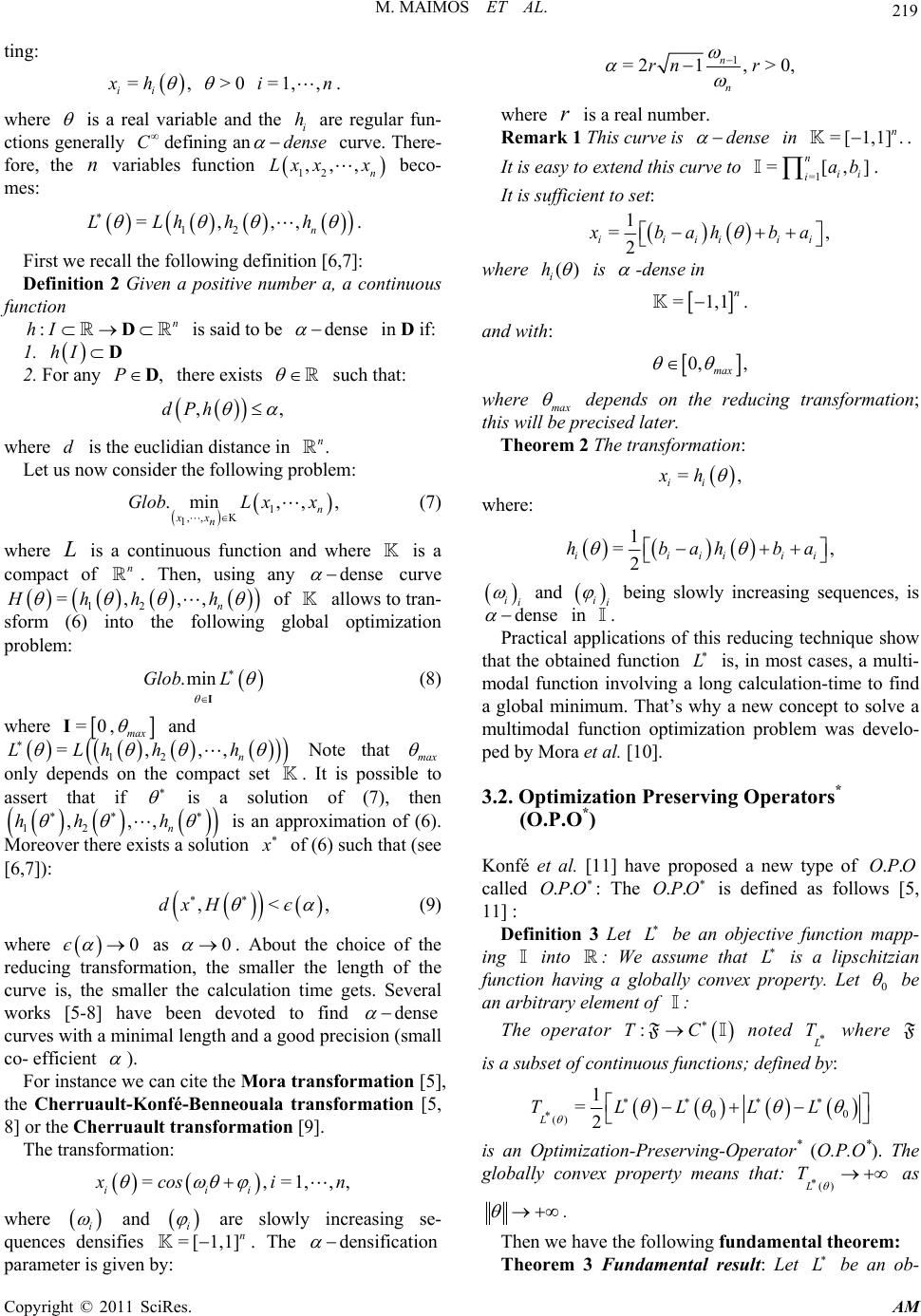 M. MAIMOS ET AL. Copyright © 2011 SciRes. AM 219 ting: =, >0 =1,, ii x hin . where is a real variable and the i h are regular fun- ctions generally Cdefining andense curve. There- fore, the n variables function 12 ,,, n Lx xx beco- mes: 12 =,,, n LLhh h . First we recall the following definition [6,7]: Definition 2 Given a positive number a, a continuous function :n hID is said to be dense in D if: 1. hI D 2. For any ,PD there exists such that: ,,dPh where d is the euclidian distance in . n Let us now consider the following problem: 1 ,, K 1 .min,, , n xx n GlobL xx (7) where L is a continuous function and where is a compact of n . Then, using any dense curve 12 =,,, n Hhh h of allows to tran- sform (6) into the following global optimization problem: .minGlob L I (8) where =0 , max I and 12 =,,, n LLhh h Note that max only depends on the compact set . It is possible to assert that if is a solution of (7), then 12 ,,, n hh h is an approximation of (6). Moreover there exists a solution x of (6) such that (see [6,7]): ,<,dx Hє (9) where 0є as 0 . About the choice of the reducing transformation, the smaller the length of the curve is, the smaller the calculation time gets. Several works [5-8] have been devoted to find dense curves with a minimal length and a good precision (small co- efficient ). For instance we can cite the Mora transformation [5], the Cherruault-Konfé-Benneouala transformation [5, 8] or the Cherruault transformation [9]. The transformation: =, =1,,, iii x cosi n where i and i are slowly increasing se- quences densifies = [1,1]n . The densification parameter is given by: 1 =21,>0, n n rn r where r is a real number. Remark 1 This curve is dense in = [1,1]. n . It is easy to extend this curve to =1 =[,] n ii iab . It is sufficient to set: 1 =, 2 iiiiii x bah ba where () i h is -dense in =1,1. n and with: 0, , max where max depends on the reducing transformation; this will be precised later. Theorem 2 The transformation: =, ii xh where: 1 =, 2 iiiiii hbahba ii and ii being slowly increasing sequences, is dense in . Practical applications of this reducing technique show that the obtained function L is, in most cases, a multi- modal function involving a long calculation-time to find a global minimum. That’s why a new concept to solve a multimodal function optimization problem was develo- ped by Mora et al. [ 10 ] . 3.2. Optimization Preserving Operators* (O.P.O*) Konfé et al. [11] have proposed a new type of ..OPO called ..OPO : The ..OPO is defined as follows [5, 11] : Definition 3 Let L be an objective function mapp- ing into : We assume that L is a lipschitzian function having a globally convex property. Let 0 be an arbitrary element of : The operator :TC F noted L T where F is a subset of continuous functions; defined by: 00 () 1 =2 L TLLLL is an Optimization-Preserving-Operator* (O.P.O*). The globally convex property means that: ()L T as . Then we have the following fundamental theorem: Theorem 3 Fundamental result: Let L be an ob-  M. MAIMOS ET AL. Copyright © 2011 SciRes. AM 220 jective function, 0 is an arbitrary element of . I Let S be the set of the solutions of: =0. L T (10) If=, then=. min I SGlobLL In other words, if S contains a unique element, it is the solution of the global minimization problem. The complete proof for this theorem is given in [11]. To solve the global optimization problem (7), we use the O.P.O* to find a unique 0 such that: =0. L T 4. Algorithm Now, we fully describe the algorithm we propose to solve our initial problem (1). The MOP problem to solve is: 12 ,,, "min" k F xfxfxfx x (11) Step 1: Use the weighted sum to aggregate the di- fferent functions and therefore obtain the following ob- jective function: 1=1 =. k ii i Sx fx (12) where =1 =1, 0. k ii i Step 2: If the problem (1) is constrained, use the penalization technique to define the multidimensional function Lx as in (13): 1=1 =, m ii i LxS xKl xl x (13) given that =0, =1,, n i Dx lxim ; other- wise, set 1 =LxS x. Step 3: Use Alienor method to convert the multi- dimensional function Lx into a one variable function L by setting: =, ii xh where: 1 =, 2 iiiiiii hbacos ba 0,2. Step 4: O.P.O* 1) Initialization. *Take an arbitrary initial point 0 in . Use OPO*: 00 0=2 L LL LL T to eliminate all local minima, i.e. solve 0=0. L T 2) *Now let i S be the set of solutions defined by: () =: =0 L ii ST If = i S then stop: is a global minimizer of F ; go to Step 3 *otherwise go to 3. 3) *update . F T *Choose ji S *then go to 2. Step 5: Find: 1 =,=1,, 2 iiii ii x bahba in where= cos,=1,, iii hwin calculate .F 5. Computational Results Computing environment: We implemented the algorithm in Maple12 software on an Intel Core2Duo CPU T5850 @2.16 GHz computer with 4 GB RAM using a windows vista Service patch 2, operating system. In order to have graphical representations, we have only considered bi-criteria problems with a large number of variables. 5.1. Example 1: Zitzler’s Test Function For the first example, we solve the well known Zitzler’s test function. Note that this example is an unconstrained MONLP problem, it has been solved in [12] and the true Pareto fronts is fo und when =1gX : 11 1 2 "min" g1 fX x f X fX XgX where 1 =2 9 =1 , =,, 1 n in i g XxXxx n 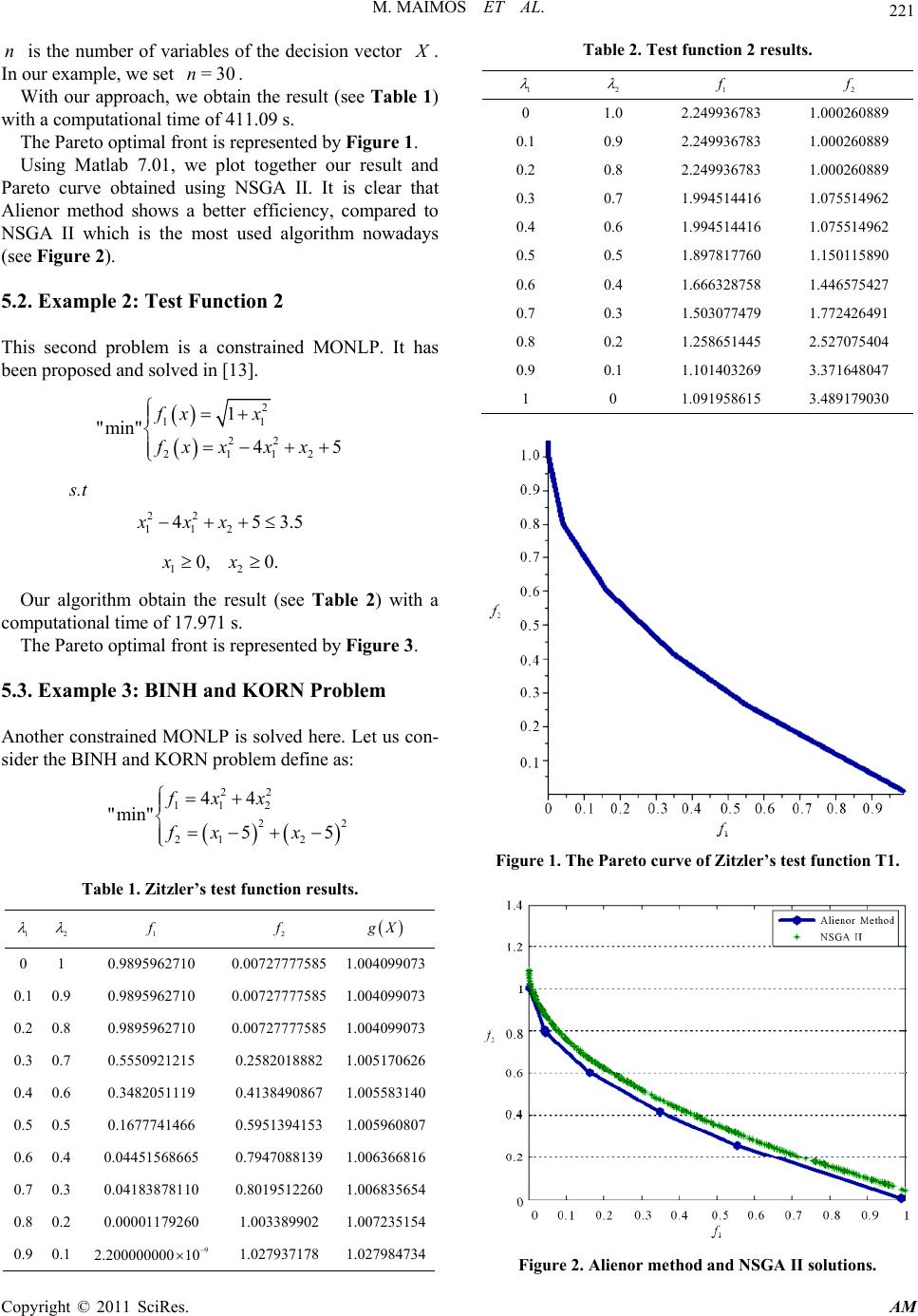 M. MAIMOS ET AL. Copyright © 2011 SciRes. AM 221 n is the number of variables of the decision vector X . In our example, we set =30n. With our approach, we obtain the result (see Table 1) with a computational time of 411.09 s. The Pareto optimal front is represented by Figure 1. Using Matlab 7.01, we plot together our result and Pareto curve obtained using NSGA II. It is clear that Alienor method shows a better efficiency, compared to NSGA II which is the most used algorithm nowadays (see Figure 2). 5.2. Example 2: Test Function 2 This second problem is a constrained MONLP. It has been proposed and solved in [13]. 2 11 22 2112 1 "min" 45 fx x fxxx x s.t 22 112 453.5xxx 12 0, 0.xx Our algorithm obtain the result (see Table 2) with a computational time of 17.971 s. The Pareto optimal front is represented by Figure 3. 5.3. Example 3: BINH and KORN Problem Another constrained MONLP is solved here. Let us con- sider the BINH and KORN problem define as: 22 112 22 21 2 44 "min" 55 fxx fx x Table 1. Zitzler’s test function results. 1 2 1 f 2 f g X 0 1 0.9895962710 0.00727777585 1.004099073 0.1 0.9 0.9895962710 0.00727777585 1.004099073 0.2 0.8 0.9895962710 0.00727777585 1.004099073 0.3 0.7 0.5550921215 0.2582018882 1.005170626 0.4 0.6 0.3482051119 0.4138490867 1.005583140 0.5 0.5 0.1677741466 0.5951394153 1.005960807 0.6 0.4 0.04451568665 0.7947088139 1.006366816 0.7 0.3 0.04183878110 0.8019512260 1.006835654 0.8 0.2 0.00001179260 1.003389902 1.007235154 0.9 0.1 9 2.200000000 10 1.027937178 1.027984734 Table 2. Test function 2 results. 1 2 1 f 2 f 0 1.0 2.249936783 1.000260889 0.1 0.9 2.249936783 1.000260889 0.2 0.8 2.249936783 1.000260889 0.3 0.7 1.994514416 1.075514962 0.4 0.6 1.994514416 1.075514962 0.5 0.5 1.897817760 1.150115890 0.6 0.4 1.666328758 1.446575427 0.7 0.3 1.503077479 1.772426491 0.8 0.2 1.258651445 2.527075404 0.9 0.1 1.101403269 3.371648047 1 0 1.091958615 3.489179030 Figure 1. The Pareto curve of Zitzler’s test function T1. Figure 2. Alienor method and NSGA II solutions. 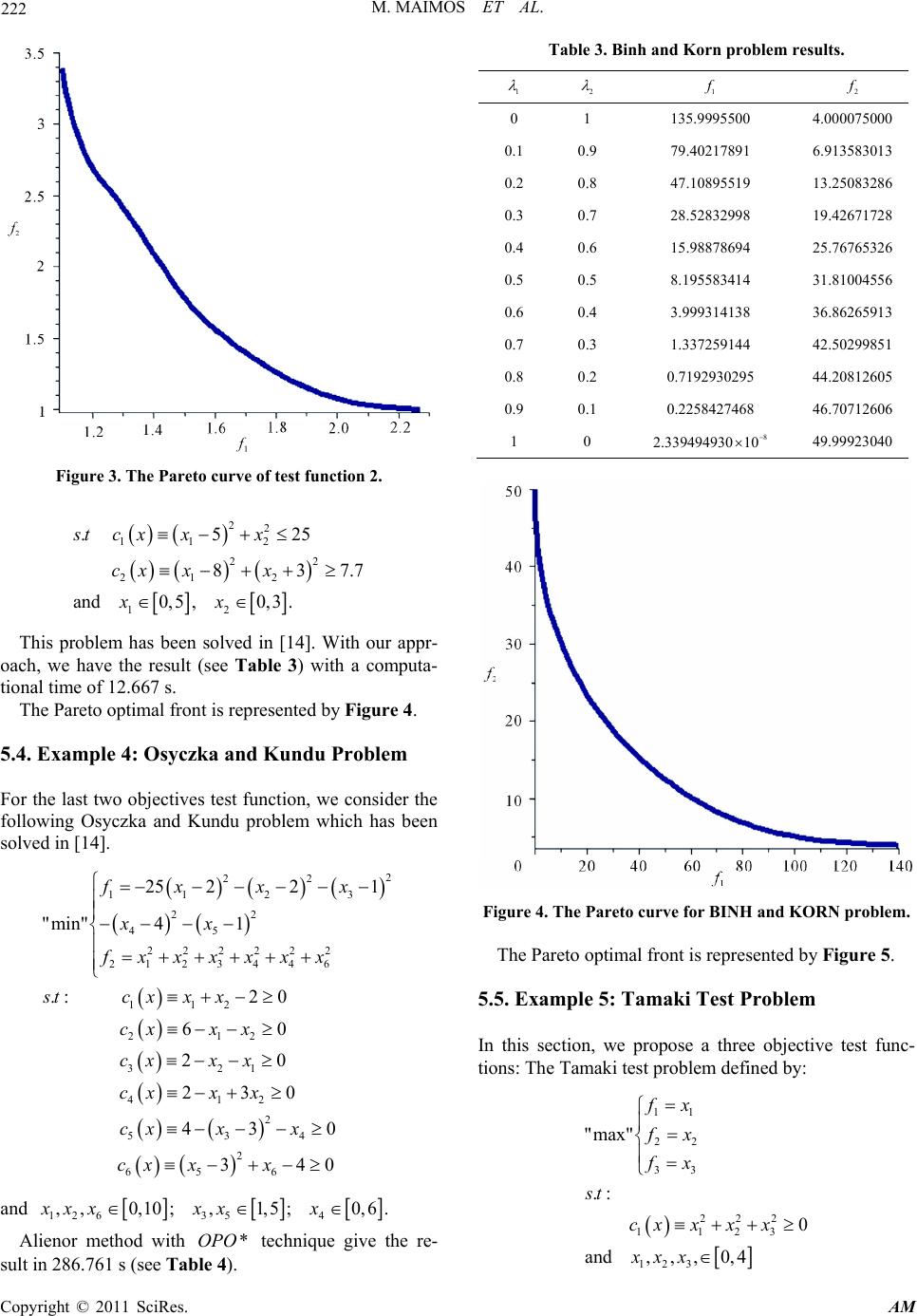 M. MAIMOS ET AL. Copyright © 2011 SciRes. AM 222 Figure 3. The Pareto curve of test function 2. 22 11 2 22 212 12 .525 837.7 and0,5,0,3 . stc xxx cx xx xx This problem has been solved in [14]. With our appr- oach, we have the result (see Table 3) with a computa- tional time of 12.667 s. The Pareto optimal front is represented by Figure 4. 5.4. Example 4: Osyczka and Kundu Problem For the last two objectives test function, we consider the following Osyczka and Kundu problem which has been solved in [14]. 2 22 11 23 2 2 45 222222 2123446 112 212 321 412 2 534 2 65 6 25 221 "min"41 .:2 0 60 20 230 43 0 340 fx xx xx f xxxxxx stc xxx cxx x cxx x cxx x cx xx cx xx and 12635 4 ,,0,10;,1,5 ;0,6 .xx xxxx Alienor method with *OPO technique give the re- sult in 286.761 s (see Table 4). Table 3. Binh and Korn problem results. 1 2 1 f 2 f 0 1 135.9995500 4.000075000 0.1 0.9 79.40217891 6.913583013 0.2 0.8 47.10895519 13.25083286 0.3 0.7 28.52832998 19.42671728 0.4 0.6 15.98878694 25.76765326 0.5 0.5 8.195583414 31.81004556 0.6 0.4 3.999314138 36.86265913 0.7 0.3 1.337259144 42.50299851 0.8 0.2 0.7192930295 44.20812605 0.9 0.1 0.2258427468 46.70712606 1 0 8 2.339494930 10 49.99923040 Figure 4. The Pareto curve for BINH and KORN problem. The Pareto optimal front is represented by Figure 5. 5.5. Example 5: Tamaki Test Problem In this section, we propose a three objective test func- tions: The Tamaki test problem defined by: 11 22 33 222 1123 12 3 "max" .: 0 and, , ,0,4 fx fx fx st cxxxx xxx 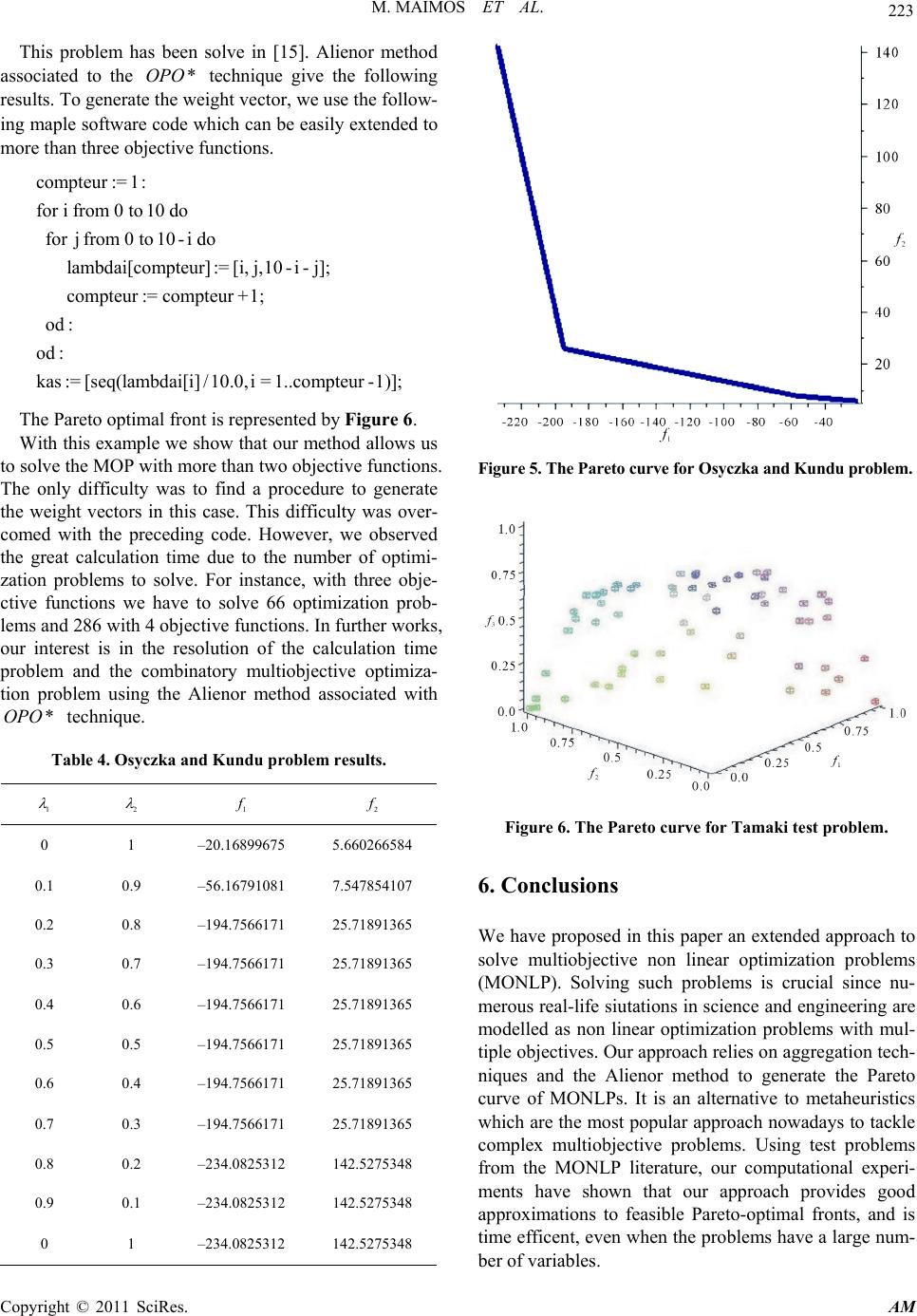 M. MAIMOS ET AL. Copyright © 2011 SciRes. AM 223 This problem has been solve in [15]. Alienor method associated to the *OPO technique give the following results. To generate the weight vector, we use the follow- ing maple software code which can be easily extended to more than three objective functions. compteur :=1: for ifrom 0to10 do forj from0to10-ido lambdai[compteur]:=[i, j,10-i-j]; compteur :=compteur +1; od : od : kas:= [seq(lambdai[i]/10.0,i=1..compteur -1)]; The Pareto optimal front is represented by Figure 6. With this example we show that our method allows us to solve the MOP with more than two objective functions. The only difficulty was to find a procedure to generate the weight vectors in this case. This difficulty was over- comed with the preceding code. However, we observed the great calculation time due to the number of optimi- zation problems to solve. For instance, with three obje- ctive functions we have to solve 66 optimization prob- lems and 286 with 4 objective functions. In further works, our interest is in the resolution of the calculation time problem and the combinatory multiobjective optimiza- tion problem using the Alienor method associated with *OPO technique. Table 4. Osyczka and Kundu problem results. 1 2 1 f 2 f 0 1 –20.16899675 5.660266584 0.1 0.9 –56.16791081 7.547854107 0.2 0.8 –194.7566171 25.71891365 0.3 0.7 –194.7566171 25.71891365 0.4 0.6 –194.7566171 25.71891365 0.5 0.5 –194.7566171 25.71891365 0.6 0.4 –194.7566171 25.71891365 0.7 0.3 –194.7566171 25.71891365 0.8 0.2 –234.0825312 142.5275348 0.9 0.1 –234.0825312 142.5275348 0 1 –234.0825312 142.5275348 Figure 5. The Pareto curve for Osyczka and Kun du prob lem. Figure 6. The Pareto curve for Tamaki test problem. 6. Conclusions We have proposed in this paper an extended approach to solve multiobjective non linear optimization problems (MONLP). Solving such problems is crucial since nu- merous real-life siutations in science and engineering are modelled as non linear optimization problems with mul- tiple objectives. Our ap proach relies o n aggreg ation tech- niques and the Alienor method to generate the Pareto curve of MONLPs. It is an alternative to metaheuristics which are the most popular approach nowadays to tackle complex multiobjective problems. Using test problems from the MONLP literature, our computational experi- ments have shown that our approach provides good approximations to feasible Pareto-optimal fronts, and is time efficent, even when the problems have a large num- ber of variables. 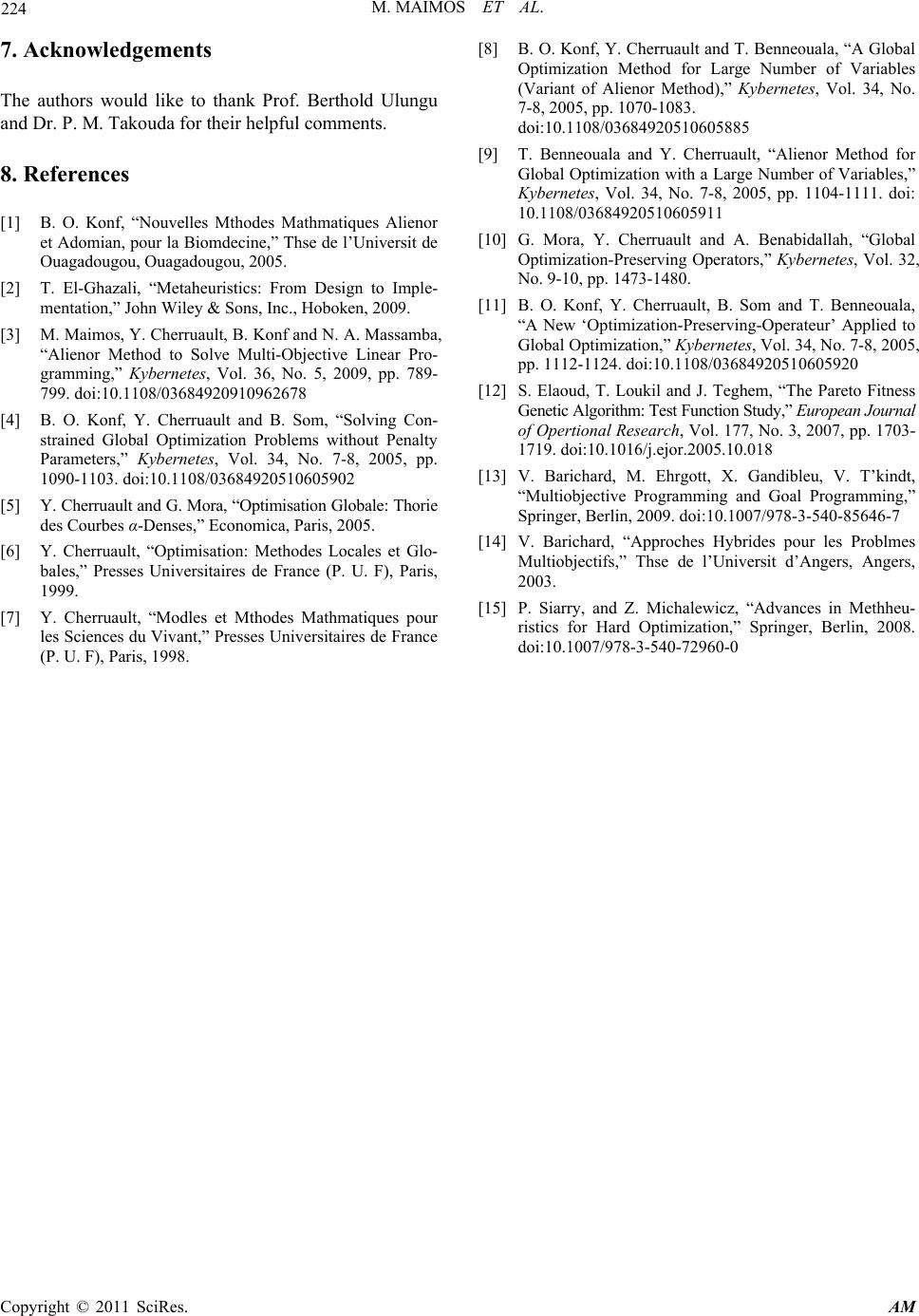 M. MAIMOS ET AL. Copyright © 2011 SciRes. AM 224 7. Acknowledgements The authors would like to thank Prof. Berthold Ulungu and Dr. P. M. Takouda for their helpful comments. 8. References [1] B. O. Konf, “Nouvelles Mthodes Mathmatiques Alienor et Adomian, pour la Biomdecine,” Thse de l’Universit de Ouagadougou, Ouagadougou, 2005. [2] T. El-Ghazali, “Metaheuristics: From Design to Imple- mentation,” John Wiley & Sons, Inc., Hoboken, 2009. [3] M. Maimos, Y. Cherruault, B. Konf and N. A. Massamba, “Alienor Method to Solve Multi-Objective Linear Pro- gramming,” Kybernetes, Vol. 36, No. 5, 2009, pp. 789- 799. doi:10.1108/03684920910962678 [4] B. O. Konf, Y. Cherruault and B. Som, “Solving Con- strained Global Optimization Problems without Penalty Parameters,” Kybernetes, Vol. 34, No. 7-8, 2005, pp. 1090-1103. doi:10.1108/03684920510605902 [5] Y. Cherruault and G. Mora, “Optimisation Globale : Thorie des Courbes α-Denses,” Economica, Paris, 2005. [6] Y. Cherruault, “Optimisation: Methodes Locales et Glo- bales,” Presses Universitaires de France (P. U. F), Paris, 1999. [7] Y. Cherruault, “Modles et Mthodes Mathmatiques pour les Sciences du Vivant,” Presses Universitaires de France (P. U. F), Paris, 1998. [8] B. O. Konf, Y. Cherruault and T. Benneouala, “A Global Optimization Method for Large Number of Variables (Variant of Alienor Method),” Kybernetes, Vol. 34, No. 7-8, 2005, pp. 1070-1083. doi:10.1108/03684920510605885 [9] T. Benneouala and Y. Cherruault, “Alienor Method for Global Optimization with a Large Number of Variables,” Kybernetes, Vol. 34, No. 7-8, 2005, pp. 1104-1111. doi: 10.1108/03684920510605911 [10] G. Mora, Y. Cherruault and A. Benabidallah, “Global Optimization-Preserving Operators,” Kybernetes, Vol. 32, No. 9-10, pp. 1473-1480. [11] B. O. Konf, Y. Cherruault, B. Som and T. Benneouala, “A New ‘Optimization-Preserving-Operateur’ Applied to Global Optimization,” Kybernetes, Vol. 34, No. 7-8, 2005, pp. 1112-1124. doi:10.1108/03684920510605920 [12] S. Elaoud, T. Loukil and J. Teghem, “The Pareto Fitness Genetic Alg or ithm: Test Function Study,” European Journal of Opertional Research, Vol. 177, No. 3, 2007, pp. 1703- 1719. doi:10.1016/j.ejor.2005.10.018 [13] V. Barichard, M. Ehrgott, X. Gandibleu, V. T’kindt, “Multiobjective Programming and Goal Programming,” Springer, Berlin, 2009. doi:10.1007/978-3-540-85646-7 [14] V. Barichard, “Approches Hybrides pour les Problmes Multiobjectifs,” Thse de l’Universit d’Angers, Angers, 2003. [15] P. Siarry, and Z. Michalewicz, “Advances in Methheu- ristics for Hard Optimization,” Springer, Berlin, 2008. doi:10.1007/978-3-540-72960-0 |

